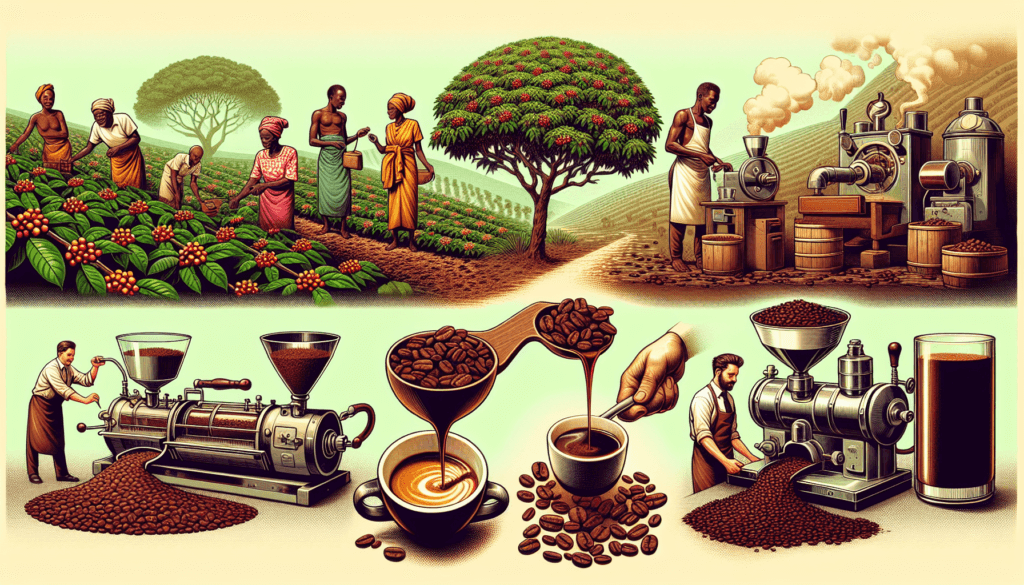Did you ever wonder what exactly your morning cup of joe is made of? It’s a question that many coffee lovers have pondered, and in this article, we’ll uncover the secrets behind the original coffee blend. From the origins of the coffee bean to the process of roasting and brewing, get ready to embark on a journey into the world of coffee and discover what makes this beloved beverage so unique and delicious. So grab your favorite mug, sit back, and prepare to be amazed by the fascinating ingredients that make up your daily caffeine fix.

History of Coffee
Discovery of coffee beans
The history of coffee dates back centuries, with its origins shrouded in legend and folklore. According to one popular tale, coffee was discovered by a goat herder named Kaldi in Ethiopia. It is said that Kaldi noticed his goats behaving energetically after consuming the red cherries from a certain tree. Intrigued by this, Kaldi decided to try the cherries himself, experiencing a similar surge of energy. This led to the realization that these cherries, which we now know as coffee beans, possessed stimulating properties.
Origin and cultivation of coffee plants
Coffee plants, botanically known as Coffea, are native to the tropical regions of Africa. The plants thrive in areas with a combination of high altitudes, ample rainfall, and a moderate climate. Ethiopia is believed to be the birthplace of coffee cultivation, where it was first cultivated and prepared as a beverage. From Ethiopia, the cultivation of coffee spread to other parts of Africa, the Middle East, and eventually to Europe and the Americas.
Introduction to the world
Coffee’s introduction to the world can be traced back to Yemen in the 15th century. The port city of Mocha became a bustling center for the trade of coffee, attracting merchants and traders from all over. It was through these traders that coffee started to make its way to Europe, where it gained popularity among the elite. Coffeehouses began to spring up in major cities, serving as meeting places for intellectuals, artists, and politicians. Over time, coffee became a global commodity, finding its way into every corner of the world.
Coffee Beans
Types of coffee beans
There are two main types of coffee beans that dominate the market – Arabica and Robusta. Arabica beans are known for their delicate flavors and aromas, and they are considered to be of higher quality. Robusta beans, on the other hand, are hardier and more resistant to diseases, making them easier to cultivate. While Arabica beans are generally preferred for their superior taste, Robusta beans are often used in blended coffees or for their higher caffeine content.
Characteristics of coffee beans
Coffee beans possess a unique set of characteristics that contribute to the overall flavor and aroma of the brewed beverage. These characteristics include acidity, body, bitterness, sweetness, and aroma. The acidity of coffee refers to its perceived brightness and liveliness on the palate. The body refers to the weight and texture of the coffee, ranging from light to full-bodied. Bitterness is a natural component of coffee, contributing to its complexity. Sweetness adds balance and can range from subtle to pronounced. Aroma refers to the fragrance or scent of the coffee, which can vary greatly depending on the origin and processing methods.
Processing of coffee beans
After the coffee cherries are harvested, they undergo a series of processing methods to remove the outer skin and pulp, revealing the coffee beans within. There are three main processing methods: washed, natural, and honey. In the washed method, the skin and pulp are removed using water, resulting in clean and bright-flavored beans. The natural method involves drying the cherries with their skin intact, allowing the sugars to ferment and imparting a fruity and intense flavor to the beans. The honey method is a hybrid of the washed and natural methods, whereby some of the mucilage is left on the beans during drying, creating a unique sweetness.

Roasting Coffee
Purpose of roasting
The roasting process is crucial in developing the flavors and aromas of coffee beans. When raw, green coffee beans are subjected to high heat, chemical reactions occur within the beans, transforming their physical and chemical properties. Roasting brings out the distinct flavors and aromas that we associate with coffee. It also removes any residual moisture, making the beans more suitable for grinding and brewing.
Roasting techniques
There are various roasting techniques employed by coffee roasters, each resulting in different flavor profiles. Light roast coffee is roasted for a shorter duration, preserving the natural flavors and acidity of the beans. Medium roast coffee strikes a balance between the original flavors and the caramelization that occurs during roasting. Dark roast coffee is roasted for a longer time, resulting in a rich and bold taste with less acidity. Each technique offers a unique experience and caters to different preferences.
Effects of roasting on flavor
The roasting process significantly impacts the flavor of coffee. Lightly roasted coffee tends to have more delicate and nuanced flavors, with hints of fruitiness or floral notes. Medium roast coffee exhibits a balance between the original characteristics of the beans and the flavors developed during roasting, often offering a pleasant sweetness. Dark roast coffee, on the other hand, can produce intense flavors with notes of chocolate, caramel, or smokiness. The longer the beans are roasted, the more the original flavors are overshadowed by the flavors created during the roasting process.
Brewing Methods
Traditional brewing methods
Throughout history, various traditional brewing methods have been used to extract the flavors and aromas from coffee beans. One such method is the Turkish or Ethiopian coffee preparation, where finely ground coffee is boiled with water and sometimes sugar to create a strong and richly flavored brew. Another traditional method is the French press, where coarsely ground coffee steeps in hot water before being pressed down to separate the liquid from the grounds.
Modern brewing methods
In recent years, a plethora of modern brewing methods has gained popularity among coffee enthusiasts. The pour-over method involves slowly pouring hot water over a filter containing coffee grounds, allowing the water to extract the flavors as it passes through the grounds and into the vessel below. The espresso machine is another common modern brewing method, utilizing pressure to force hot water through finely ground coffee in a short amount of time, resulting in a concentrated and flavorful shot of coffee.
Variations in brewing techniques
Within each brewing method, there are numerous variations and techniques that can further influence the flavor and characteristics of the brewed coffee. Factors such as water temperature, brew time, grind size, and the ratio of coffee to water can all be adjusted to achieve specific results. This allows coffee aficionados to explore and experiment, tailoring their brewing techniques to their personal preferences and desired flavor profiles.

Chemical Composition of Coffee
Major chemical compounds in coffee
Coffee contains a complex array of chemical compounds that contribute to its aroma, flavor, and physiological effects. One of the key compounds is caffeine, a naturally occurring stimulant that is responsible for the energizing effects of coffee. Additionally, coffee contains various organic acids, such as chlorogenic acid and quinic acid, which contribute to its acidity. Other important chemical compounds include carbohydrates, proteins, and lipids, which all play a role in the overall composition of coffee.
Impact on aroma and flavor
The chemical compounds in coffee are responsible for its distinct aroma and flavor profile. Volatile compounds, such as those found in coffee’s oils, contribute to its aromatic qualities and can vary depending on the roast level and brewing method. The balance of acids and sugars present in coffee also influences its flavor, with varying levels of acidity, bitterness, and sweetness. The chemical composition of coffee is highly complex, and slight variations can lead to significant changes in taste and aroma.
Beneficial components
Coffee contains a number of beneficial components that have been studied for their potential health benefits. Antioxidants, such as chlorogenic acid and caffeine, have been found to have anti-inflammatory properties and may contribute to the prevention of certain chronic diseases. Coffee also contains minerals, such as magnesium and potassium, which are important for various bodily functions. However, it is important to note that the potential health benefits of coffee should be considered in moderation and in the context of an overall healthy lifestyle.
Caffeine Content
Caffeine in coffee
Caffeine is a natural stimulant found in varying amounts in coffee beans. The caffeine content of coffee can vary depending on factors such as the type of coffee bean, the brewing method, and the serving size. Arabica beans generally contain less caffeine than Robusta beans. On average, a cup of coffee contains between 80 to 100 milligrams of caffeine, but this can range from as little as 30 milligrams to over 200 milligrams in certain specialty coffees or brewing methods.
Factors affecting caffeine content
Several factors can influence the caffeine content of a cup of coffee. The type of coffee bean used is a major factor, with Robusta beans containing about twice the amount of caffeine as Arabica beans. The degree of roasting can also impact caffeine levels, with darker roasts typically having slightly less caffeine than lighter roasts. The brewing method and brewing time can also affect caffeine extraction, as longer brew times tend to result in more caffeine extraction.
Effects of caffeine on the body
Caffeine is known for its stimulating effects on the central nervous system, helping to increase alertness and combat fatigue. It can temporarily improve focus and concentration, as well as enhance physical performance. However, excessive consumption of caffeine can lead to side effects such as restlessness, increased heart rate, and insomnia. Individual sensitivity to caffeine can vary, and it is important to listen to your body and consume coffee in moderation to avoid any negative effects.

Flavor Profiles
Acidity
Acidity in coffee refers to the perceived brightness or liveliness on the palate. It can range from low to high, with some coffees exhibiting a crisp and vibrant acidity, while others have a more mellow and subtle acidity. Acidity adds complexity and balance to the overall flavor profile of coffee.
Bitterness
Bitterness is a natural component of coffee and can vary depending on factors such as the roast level and brewing method. Some people enjoy the bitterness as it adds depth and complexity to the coffee’s flavor profile, while others prefer a milder and less bitter taste. Balancing bitterness with other flavors is key to achieving a well-rounded cup of coffee.
Aroma
The aroma of coffee is one of its most captivating qualities. It can range from floral and fruity to nutty or chocolatey, depending on the coffee bean’s origin, roast level, and brewing method. The aroma greatly enhances the overall coffee-drinking experience, enticing the senses before even tasting the beverage.
Body
The body of coffee refers to its weight and texture on the palate, ranging from light to full-bodied. A light-bodied coffee has a thinner mouthfeel and is often associated with delicate flavors, while a full-bodied coffee has a thicker, heavier mouthfeel and can exhibit more pronounced flavors. The body of coffee contributes to its overall richness and complexity.
Sweetness
Sweetness in coffee can vary depending on the brewing method, roast level, and the natural sweetness of the beans themselves. Some coffees have subtle hints of sweetness, while others are known for their pronounced sweetness. A balanced amount of sweetness can help to counterbalance acidity and bitterness, resulting in a more enjoyable cup of coffee.
Coffee’s Impact on Health
Health benefits
Coffee has been the subject of numerous studies examining its potential health benefits. Moderate coffee consumption has been associated with a reduced risk of certain diseases, such as type 2 diabetes, Parkinson’s disease, and liver disease. The antioxidants found in coffee have been shown to have anti-inflammatory properties and may contribute to overall health and well-being. Additionally, the caffeine in coffee can improve cognitive function, enhance athletic performance, and promote alertness.
Concerns and drawbacks
While coffee can have its benefits, excessive consumption or consumption by individuals with certain health conditions may pose concerns. For some people, excessive caffeine intake can lead to jitteriness, anxiety, and sleep disturbances. Pregnant women and individuals with certain heart conditions or gastrointestinal disorders may need to restrict their coffee consumption. Additionally, the additives and preparation methods commonly associated with coffee, such as milk, cream, and sweeteners, can add extra calories and potential health risks.
Moderate consumption
As with most things in life, moderation is key when it comes to coffee consumption. Enjoying a few cups of coffee per day can provide the potential health benefits associated with moderate coffee consumption, while minimizing any potential risks. It is important to listen to your body and be aware of any adverse effects that excessive caffeine intake may have on your overall well-being. By practicing moderation and making conscious choices regarding the preparation and additives in your coffee, you can continue to enjoy coffee as part of a balanced and healthy lifestyle.

Popular Coffee Varieties
Arabica coffee
Arabica coffee is the most widely consumed and highly regarded coffee variety, known for its delicate flavors, pleasant acidity, and complex aromas. It accounts for a significant portion of the world’s coffee production and is grown in countries such as Colombia, Brazil, Ethiopia, and Guatemala. Arabica beans are often favored by specialty coffee roasters for their superior quality and nuanced flavor profiles.
Robusta coffee
Robusta coffee, as the name suggests, is a more robust and durable coffee variety compared to Arabica beans. It has a higher caffeine content and is known for its strong and bitter flavor profile. Robusta beans are commonly used in blends and instant coffees, as they are more affordable and provide a stronger caffeine kick. While Robusta beans may not possess the same complexity and delicate flavors of Arabica, they still have their own unique appeal.
Other notable varieties
Besides Arabica and Robusta, there are other coffee varieties worth mentioning. For example, Liberica coffee, which originated in West Africa, is known for its distinctively large and asymmetrical beans and has a unique flavor profile. Additionally, Excelsa coffee, another variety originating from West Africa, is often included in specialty blends for its fruity and complex flavors. These lesser-known varieties offer coffee enthusiasts a chance to explore unique tastes and expand their coffee horizons.
Sustainable Coffee Production
Environmental impact
The production of coffee can have both positive and negative effects on the environment. Coffee cultivation often requires clearing large areas of land, leading to deforestation and loss of biodiversity. Additionally, the use of chemical fertilizers and pesticides can have a detrimental impact on soil health and water quality. However, sustainable farming practices, such as organic farming and shade-grown coffee, aim to minimize the environmental impact of coffee production by preserving ecosystems and utilizing natural methods of pest control.
Fair trade practices
Fair trade practices aim to ensure that coffee farmers receive fair wages and work under safe conditions. Fair trade organizations establish minimum prices for coffee, providing a safety net for farmers, and encourage the use of ethical labor practices. By purchasing coffee with fair trade certification, consumers can support these initiatives and contribute to a more equitable coffee industry.
Certifications
Various certifications in the coffee industry help identify sustainable and ethically produced coffees. The Rainforest Alliance certification focuses on sustainable farming practices and conservation efforts. The Organic certification guarantees that coffee is produced without the use of synthetic fertilizers or pesticides. Additionally, the Direct Trade model promotes transparency and fair relationships between coffee producers and buyers, ensuring that farmers receive a fair share of the profits. By looking for these certifications, consumers can make more informed choices and support sustainable coffee production practices.
In conclusion, the history of coffee is a fascinating journey that spans centuries and continents, bringing people together through the love of this beloved beverage. From its discovery in Ethiopia to its global popularity today, coffee has evolved into an art and a science. The cultivation, processing, roasting, and brewing methods all contribute to the diverse flavors and aromas that coffee enthusiasts cherish. Understanding the chemical composition, caffeine content, and flavor profiles of coffee allows us to appreciate its complexity and make informed choices.
While coffee offers potential health benefits and a variety of flavors to suit individual preferences, it is important to consume it in moderation and be mindful of any potential drawbacks. By supporting sustainable coffee production practices and seeking out certifications for ethical and environmentally friendly practices, we can ensure a more sustainable future for the coffee industry. So go ahead, savor each cup, explore different varieties, and embrace the rich history and culture that coffee brings into your daily life.


